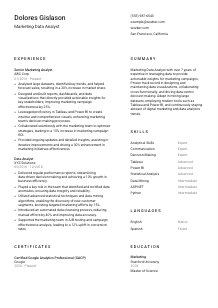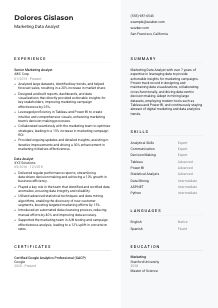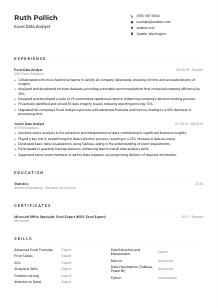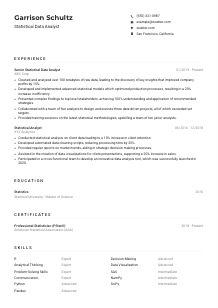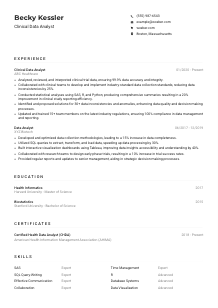Marketing Data Analyst Resume Example
Deciphering data trends, but your resume doesn't translate? Dive into this Marketing Data Analyst resume example, structured with Wozber free resume builder. Grasp how to bridge your analytical acumen with job specifics, propelling your career insights as swiftly as your data dashboards!

How to write a Marketing Data Analyst Resume?
Greetings, future Marketing Data Analyst wizard! In a world where every click, like, and purchase can be data to drive business decisions, your resume is your golden ticket. It's not only a document but it's your stage to shine, showcasing your analytical prowess and data-driven mindset. Through Wozber's intuitive free resume builder, this guide will help you sculpt a resume that's not just a fit, but a perfect match for the Marketing Data Analyst position you're eyeing.
Ready to take your career to the next level? Let's dive into making your resume a beacon of insights, tailored to meet the very heart of your dream job.
Personal Details
Though it may seem straightforward, the Personal Details section sets the stage for your resume. It's your first 'Hello!' to prospective employers, and getting it right could mean the difference between a glance and a double-take. Here's how to ensure this section is fine-tuned for your Marketing Data Analyst application.
1. Brand Yourself
Think of your name as the headline of your professional story. Ensure it's in a clean, professional font, perhaps a touch larger than the rest of your resume. This is not just about aesthetics; it's about making your brand memorable at a glance.
2. Job Title Alignment
Imagine the hiring manager's eyes lighting up because you've listed the exact position they're hiring for right beneath your name. "Marketing Data Analyst" is not just a job title; it's your current ambition. Putting it front and center aligns your resume with the job and makes it easier for ATS to recognize the fit.
3. Essentials of Contact
Your phone number and a professional email (ideally firstname.lastname@email.com) are must-haves. Triple-check for accuracy. Imagine missing out on your dream job due to a typo!
4. Location, Location, Location
For this role, being in San Francisco is key. Make sure your location matches the job description's requirements to show there's no need for relocation.
5. Digital Footprint
Linking a LinkedIn profile or personal portfolio can add depth to your application, offering a fuller picture of your professional self. Ensure any linked content is current, clean, and mirrors your resume's highlights.
Takeaway
With these steps, your Personal Details section becomes more than a formality. It summarizes who you are, where you are, and how to connect—the pillars upon which the rest of your resume will stand. Picture it as your professional greeting; make it count!





Experience
In the Experience section, you bridge your past achievements to your future aspirations. It's where you prove you're not just capable but exceptional. Ready to make your experience resonate with the needs of a Marketing Data Analyst role? Here we go.
- Analyzed large datasets, identified key trends, and helped forecast sales, resulting in a 20% increase in market share.
- Designed and built reports, dashboards, and data visualizations that directly provided actionable insights for key stakeholders, improving marketing campaign effectiveness by 25%.
- Leveraged proficiency in Tableau and Power BI to create intuitive and comprehensive visuals, enhancing marketing team's decision‑making processes.
- Collaborated seamlessly with the marketing team to optimize strategies, leading to a 15% increase in marketing campaign ROI.
- Provided ongoing updates and detailed insights, assisting in iterative improvements and driving a 30% enhancement in marketing initiatives effectiveness.
- Delivered regular performance reports, streamlining data‑driven decision‑making and achieving a 10% growth in business efficiency.
- Played a key role in the team that identified and rectified data anomalies, ensuring data integrity and reliability.
- Utilized advanced statistical techniques and data mining algorithms, enabling the discovery of new customer segments, boosting targeted marketing efforts by 15%.
- Introduced an automated data cleansing process, reducing manual efforts by 40% and improving data accuracy.
- Supported the marketing team in A/B testing and campaign effectiveness analysis, leading to a 12% uplift in conversion rates.
1. Dissecting the Job Requirements
Start with a highlighter and the job description. Identify phrases like "analyze large datasets" or "measure marketing campaign performance" and think on how your past roles align with these tasks.
2. Present Your Professional Journey
List your roles in reverse-chronological order, focusing on duties and achievements that echo the job description. Remember, it's about painting a picture of growth and relevance.
3. Achievement-Focused Bullets
Instead of listing duties, highlight achievements. Use action verbs and quantify results when possible. For instance, "Leveraged Tableau and Power BI to enhance marketing decision-making processes."
4. Quantify Your Success
Numbers speak volumes. When you say "increased market share by 20%," it instantly paints a picture of the impact you can have on a business.
5. Relevance Is Key
Every bullet point should serve a purpose and relate back to the job description. Irrelevant accomplishments, no matter how notable, can dilute the potency of your application.
Takeaway
Think of the Experience section as your career highlight reel tailored for the role of a Marketing Data Analyst. This isn't just about what you've done; it's a showcase of how what you've done aligns perfectly with what you aim to do next. Pack this section with quantifiable achievements and relevant successes, and you'll have a winning narrative.
Education
The Education section does more than list degrees. It's a reaffirmation of your foundational expertise and how it prepares you for the Marketing Data Analyst role. Let's explore how to shape this section to highlight its relevance.
1. Identify Key Educational Insights
Review the job description for educational prerequisites. A Bachelor's in a field like Data Analytics sets the stage for your analytical prowess, aligning with the employer's expectations.
2. Structure and Simplicity
Keep this section straightforward. List your degree, the institution, and graduation year. Clarity trump's complexity here, making it easy for both ATS and human eyes to scan.
3. Degree Details Matter
Tailor your degree listing to reflect both the requirements of the job and your academic background. For instance, your "Bachelor of Science in Data Analytics" directly echoes the job's prerequisites.
4. Relevant Courses Can Add Value
While the broader degree might cover it, mentioning specific courses can underscore your expertise, especially if those courses align closely with the job's skill requirements.
5. Additional Educational Achievements
If there are honors, clubs, or projects particularly relevant to data analytics or marketing, include these. They add depth to your academic profile and show commitment beyond coursework.
Takeaway
Your Education section is more than a list of degrees. It's an opportunity to underscore the foundations of your expertise, aligned with what's sought by your potential employers. Every line should reflect the relevance and preparedness you bring to the Marketing Data Analyst role.
Certificates
In the dynamic field of data analytics and marketing, certifications can set you apart, signaling your commitment to keeping your skills sharp. Let's walk through how to curate this section for maximum impact.
1. Relevant Certifications First
While the job description might not specify certifications, including relevant ones such as "Certified Google Analytics Professional" showcases your dedication to the craft and adds an extra layer of credibility.
2. Quality Over Quantity
List certifications that are most relevant to the job. This keeps your resume focused and resonant with the hiring manager's needs.
3. Dates Demonstrate Dedication
Including the date of certification shows recency and implies an up-to-date skill set, a crucial aspect in the fast-evolving field of data analysis.
4. Commitment to Continuous Learning
Regularly update your certifications and pursue new ones in areas aligned with your marketing and data analytics career path. It shows potential employers your commitment to staying at the top of your game.
Takeaway
In a field where knowledge rapidly evolves, certifications aren't just credentials—they're proof of your ongoing commitment to excellence. Highlight certifications that resonate most with the role, and remember, continuous learning is your secret weapon.
Skills
The Skills section is where you get to shine a spotlight on your professional toolkit. Here's how to ensure your skills are not only listed but are compellingly relevant to the role of a Marketing Data Analyst.
1. Decipher the Job Description
Scrutinize the job posting for explicit skills like "proficiency in Tableau or Power BI" and implicitly required skills such as "analytical thinking." Your task is to match and elucidate these skills drawing from your own arsenal.
2. Highlighting the Essentials
Focus on key skills that resonate directly with the job description. Your ability to employ Tableau and Power BI for actionable insights is a crown jewel; make it prominent.
3. A Tidy Presentation
Avoid overcrowding your resume with every skill you possess. A concise, targeted list speaks volumes about your understanding of the role's demands and your ability to meet them head-on.
Takeaway
Consider the Skills section as an arsenal, where each skill you list is a weapon in your professional repertoire. Tailor this section with precision, choosing only those skills that align closely with the job's demands. Poise yourself as the candidate who doesn't just meet expectations but exceeds them.
Languages
In a global market, the ability to communicate across cultural and linguistic barriers is invaluable. Here's how to frame your multilingual prowess in alignment with a Marketing Data Analyst's role.
1. Relevance Check
First, ascertain if the job description emphasizes language skills. For the Marketing Data Analyst position, proficiency in English is a must. Other languages could set you apart, showcasing global market readiness.
2. Prioritize Accordingly
List English first, indicating your proficiency level. Then, mention any additional languages you speak. This shows you're not just a local talent but have global communication capabilities.
3. More Is Better
While English is essential, fluency in languages like Spanish or Mandarin can be a significant asset, particularly in roles requiring market analysis across different geographies.
4. Honesty in Proficiency
Be transparent about your language skills. Overstating your proficiency could lead to awkward situations, especially if the role requires communicating with stakeholders in those languages.
5. Consider the Job's Scope
While the ability to operate in English is a must, fluency in other languages could be the icing on the cake, especially in roles with a global focus or those targeting specific demographics.
Takeaway
Your linguistic skills are more than just a line on a resume; they are a bridge to new markets and opportunities. Even if the job doesn't explicitly require multilingual skills, showcasing your language proficiency indicates an openness and adaptability that is highly valued in today's global marketplace.
Summary
A compelling summary is your chance to make a lasting first impression. It's the hook that encourages hiring managers to dive deeper into your resume. Let's craft a summary that positions you as the ideal candidate for a Marketing Data Analyst position.
1. Digest the Job Essence
Understanding the core of the job helps tailor your summary. For a Marketing Data Analyst, it's about translating complex data into actionable insights for business growth.
2. Start Strong
Begin with an introductory sentence that encapsulates your professional identity. Align it with the values and expectations of the Marketing Data Analyst role to instantly connect with the hiring manager.
3. Satisfy Key Requirements
Mention your prime skills and notable accomplishments. "Leveraging Tableau and Power BI to enhance marketing strategies" directly addresses the job demands, making your fit undeniable.
4. Brevity Is the Soul of Wit
Your summary should be crisp, compelling, and concise. Aim for 3-5 lines that encapsulate your skills, experience, and how they align with the job requirements. Leave them wanting more.
Takeaway
Your summary is not just an introduction; it's your personal pitch. By closely aligning it with the job's demands, you make it impossible for the hiring manager to overlook your application. Just like a well-crafted ad, your summary should captivate, engage, and motivate them to learn more about you.
Launching Your Marketing Data Analyst Journey
Congratulations on completing this comprehensive guide! With these insights and Wozber's free resume builder at your disposal, you're equipped to craft an ATS-compliant resume that not only matches the job description but demonstrates your unique value as a Marketing Data Analyst. Remember, your resume is more than a collection of experiences; it's a narrative of your professional journey.
Use Wozber's ATS-friendly resume templates and ATS resume scanner to ensure your story is heard loud and clear. Now, go forth and channel your inner analyst – your next big opportunity awaits!

- Bachelor's degree in Marketing, Statistics, Data Analytics, or a related field.
- Minimum of 3 years of experience in marketing analytics or data analysis.
- Proficiency with data visualization tools such as Tableau or Power BI.
- Strong analytical skills with expertise in data mining and statistical analysis.
- Excellent communication and presentation skills, with the ability to translate complex findings into actionable insights.
- Must be able to operate effectively in English.
- Must be located in San Francisco, California.
- Analyze large datasets to identify trends, forecast sales, and measure marketing campaign performance.
- Design, build, and maintain reports, dashboards, and data visualizations that provide insights for key stakeholders.
- Collaborate with the marketing team to identify opportunities for optimization and support decision-making processes.
- Provide ongoing performance updates and insights based on marketing initiatives.
- Stay updated with the latest digital marketing and data analytics trends and tools to provide the most relevant insights.





